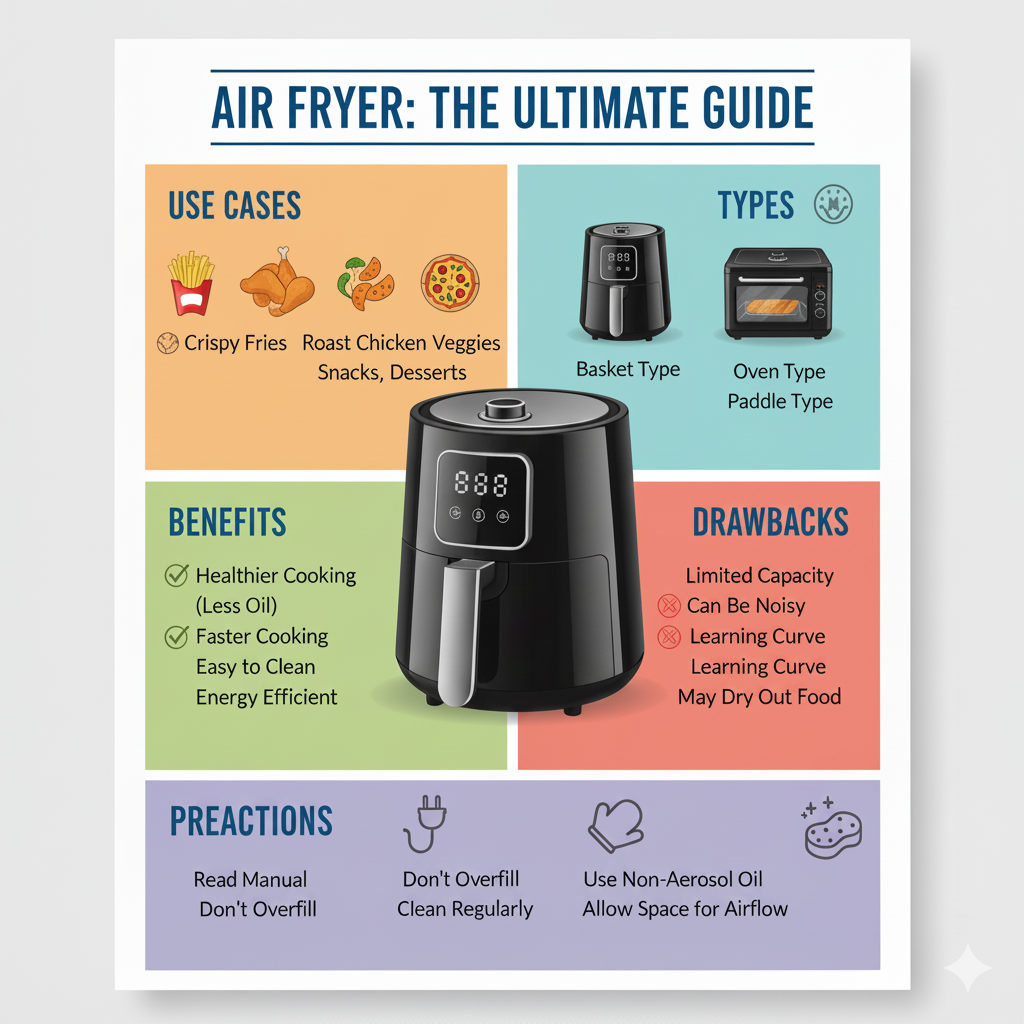Let’s be real, air fryers are awesome. They’ve totally changed the game in healthy home cooking. But here’s the kicker: not all air fryers are created equal. Many contain toxic materials like Teflon or BPA plastics that can be harmful when heated. So, if you’re trying to keep your cooking clean and chemical-free, it’s time to talk about non-toxic air fryers. Don’t worry, we’ve got you covered from choosing the right one to making the most of it.
Understanding Air Fryer Materials
Common Toxic Materials to Avoid
Some air fryers still come with coatings and parts that you really don’t want near your food:
- Teflon (PTFE): Non-stick, yes. But when overheated, it can release toxic fumes.
- BPA Plastic: Found in cheap plastics, BPA is a known hormone disruptor.
- PFOA and PFAS: These are “forever chemicals” used in non-stick surfaces — and they stick around in your body too.
Safe Materials to Look For
Here’s what your non-toxic air fryer should be made of:
- Stainless Steel: Durable, safe, and super easy to clean.
- Ceramic: Naturally non-stick and free from toxins.
- Glass Components: Great for visibility and completely non-reactive.
- BPA-Free Plastic: Still plastic, but much safer for cooking.
Top Features of a Non-Toxic Air Fryer
Material Certification
Look for terms like BPA-free, PTFE-free, or certifications from organizations like FDA or LFGB (European standard).
Temperature Control & Safety Features
Overheating is a big no-no. Adjustable temp settings and auto shut-off features help maintain safe usage.
Size and Capacity
Cooking for one? A 2-quart model is perfect. Feeding a family? Look for something 5 quarts or larger.
Ease of Cleaning
Dishwasher-safe baskets made of stainless steel or ceramic = less hassle for you.
Popular Brands That Offer Non-Toxic Air Fryers
- Philips
- Agarao
- Inlasa
- Pigeon
- Havells
- Prestige
- Wonderchef
- Kent
How to Verify If an Air Fryer is Truly Non-Toxic
Check Product Descriptions Carefully
Scan for terms like “PTFE-free”, “PFOA-free”, “ceramic-coated”, or “stainless steel basket.”
Look for Third-Party Certifications
Trust seals from FDA, SGS, or LFGB ensure that your device has been independently tested.
Read Real Customer Reviews
Skip the marketing. Real users will call out toxins if they exist.
Tips for Using a Non-Toxic Air Fryer Safely
Avoid Parchment Paper: It can be dangerous in air fryers due to the risk of ignition.
Silicone Liners: These can be a great alternative to non-stick liners and are safe up to high temperatures.
Temperature Considerations: Most air fryers operate at temperatures below 400°F (200°C), which is safe for most materials.
Avoid Metal Utensils: These can scratch non-stick coatings, potentially releasing harmful particles.
Regular Cleaning: Clean your air fryer after each use to prevent the buildup of food particles, which can sometimes be toxic.
Replace Worn Items: If the non-stick coating starts to flake, it’s time to replace the air fryer.
Pros and Cons of All Non-Toxic Air Fryers
Stainless Steel Air Fryers
Pros:
No Non-Stick Coating: Stainless steel air fryers do not have any non-stick coatings, which can be a concern for some people due to potential health risks associated with Teflon and other non-stick materials.
Durable and Long-Lasting: Stainless steel is known for its durability and resistance to wear and tear.
Easy to Clean: Stainless steel is generally easier to clean compared to non-stick coatings, although some users find it more challenging than non-stick.
Cons:
Higher Cost: Stainless steel air fryers tend to be more expensive than those with non-stick coatings.
Potential for Food to Stick: Without a non-stick coating, food might stick to the basket, requiring more oil or frequent scrubbing.
Ceramic Coated Air Fryers
Pros:
Non-Toxic Coating: Ceramic coatings are often used as a non-toxic alternative to Teflon.
Good Non-Stick Performance: Ceramic coatings provide a decent non-stick surface, making cooking and cleaning easier.
Heat Resistance: Ceramic coatings can withstand high temperatures, although they might not be as durable as stainless steel.
Cons:
Durability Issues: Ceramic coatings can sometimes chip or peel off, especially if not handled carefully.
Maintenance: Requires gentle handling and non-abrasive cleaning to avoid damaging the coating.
Glass Air Fryers
Pros:
Visible Cooking: Glass air fryers allow you to see the food as it cooks, which can be a plus for some users.
Easy to Clean: Glass is generally easy to clean and does not retain odors.
Non-Toxic: Glass is non-toxic and does not leach chemicals into food.
Cons:
Fragility: Glass can be more fragile compared to stainless steel or ceramic, and it needs careful handling.
Size and Weight: Glass air fryers can be larger and heavier, which might be a consideration for those with limited space.
Oven-Style Air Fryers
Pros:
Large Capacity: Oven-style air fryers often have a larger capacity, making them suitable for families or those who cook in larger batches.
Versatile: Many models can also function as a toaster oven, providing additional utility.
No Non-Stick: Typically, these models do not use non-stick coatings, making them a safe option for those concerned about Teflon.
Cons:
Larger Footprint: These models tend to take up more counter space compared to basket-style air fryers.
Complexity: Some users find them more complex to operate compared to simpler basket-style models.
How to Cook Healthier Meals Using Your Air Fryer

Best Foods to Cook
Think crispy veggies, salmon, tofu, chicken wings, and even desserts — all with minimal oil.
Tips to Reduce Oil Usage
Spray bottles work better than pouring. You need way less oil than you think.
Seasoning Without Harmful Chemicals
Avoid pre-made seasoning packets that contain MSG or artificial colors. Go natural with garlic, herbs, and spices.
Cleaning and Maintenance of a Non-Toxic Air Fryer
How to Clean Ceramic or Stainless-Steel Baskets
Use warm water, a soft cloth, and baking soda for stubborn stains. No steel wool, ever.
Avoiding Harsh Chemical Cleaners
Skip bleach and ammonia. Opt for natural cleaners like vinegar and lemon juice.
Conclusion
Choosing a non-toxic air fryer is a smart way to protect your health while enjoying healthier, oil-free cooking. Avoid models with Teflon, BPA, PFOA, and PFAS, and look for ceramic, stainless steel, glass, or BPA-free plastic components instead.
Stick with trusted brands, check certifications, and always read customer reviews. With the right model, you’ll cook safer, cleaner, and tastier meals—without any toxic risks.
FAQ’s
An air fryer works by circulating hot air around your food at high speed, creating a crispy outer layer—just like deep frying, but without all the oil. It uses a heating element and a powerful fan to cook food evenly from all sides, making it perfect for healthier meals with less fat. Think of it like a compact convection oven that delivers that delicious crunch without the guilt. Whether you’re making fries, chicken, or veggies, an air fryer gives you the crispy texture you love in a faster, cleaner, and healthier way.
A top air fryer isn’t just about wattage or looks—it’s one that balances safety, performance, and convenience. The best models today are non‑toxic: they avoid PTFE/Teflon and PFOA; use ceramic, stainless steel, or glass for parts that touch food; and have firm safety certifications. Among the favorites are the Philips HL9252/00 4.1 Litre Air Fryer, known for its PFAS‑free ceramic coating and even dual‑zone heating, as well as the Philips NA231/00 Air Fryer, praised for its ceramic cooking surface, solid capacity, and reliable crisping.
Yes, air fryers are generally safe to use, especially when made with non-toxic materials like ceramic or stainless steel. They cook using rapid air circulation, not hot oil, so there’s less risk of burns or grease fires. Just make sure to choose a model that’s free from harmful chemicals like Teflon (PTFE), PFOA, and BPA. Stick to FDA-approved or certified BPA-free appliances, and always follow the manufacturer’s safety guidelines. With the right air fryer, you can enjoy healthier, safer, and low-oil cooking with peace of mind.
Absolutely! Air fryers can bake cakes just like a mini oven—and often faster. With their powerful hot air circulation, they provide even baking and a nice, fluffy texture. Just use a cake-safe pan that fits your air fryer basket, set the right temperature (usually around 320°F or 160°C), and check it with a toothpick like you would in an oven. It’s perfect for baking small, quick treats without heating up your whole kitchen. So yes, you can enjoy a moist, delicious cake—right from your air fryer!
Air fryers don’t directly cause cancer, but there are a few concerns to be aware of. Some low-quality models use Teflon or PTFE coatings, which can release toxic fumes when overheated—these chemicals (like PFOA and PFAS) have been linked to health risks, including cancer. Also, cooking starchy foods at high temperatures (like fries) can create acrylamide, a chemical that may increase cancer risk. The good news? You can avoid these risks by choosing a non-toxic air fryer and cooking at recommended temperatures. Used correctly, air fryers are a safe and healthier alternative to deep frying.



